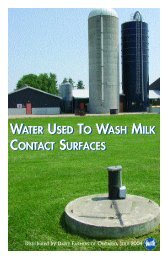Canadian Quality Milk On-Farm Food Safety Program - Centre ...
Canadian Quality Milk On-Farm Food Safety Program - Centre ...
Canadian Quality Milk On-Farm Food Safety Program - Centre ...
You also want an ePaper? Increase the reach of your titles
YUMPU automatically turns print PDFs into web optimized ePapers that Google loves.
<strong>Canadian</strong> <strong>Quality</strong> <strong>Milk</strong><br />
Introduction<br />
Producing safe milk is possible on a continuous basis if every person involved with<br />
milking works consistently. Best management practices are the<br />
foundation of a food safety program. Establishing standard<br />
operating procedures (SOPs) is the first step in applying BMPs in<br />
a consistent manner. Consistency with a repetitive task, such as<br />
milking, is necessary not only to produce safe milk, but also to<br />
produce it efficiently.<br />
Standard operating procedures help you and your staff to:<br />
• Know which animals produce milk that cannot go into the<br />
bulk tank - to prevent contamination of milk in the bulk tank.<br />
• Ensure that all staff<br />
wear clean clothing<br />
for each milking.<br />
Clothing soiled by<br />
manure or bedding<br />
can carry bacteria<br />
such as E. coli.<br />
• Practice good<br />
personal hygiene by<br />
washing hands.<br />
• Apply the same milking routine to each milking - essential to obtain good milking<br />
performance.<br />
SOPs need to be posted or readily accessible and regularly updated. Employees need<br />
to be trained and SOPs need to be evaluated on a regular basis to ensure consistency.<br />
Samples of some standard SOP forms can be found in the Workbook in Chapter C.<br />
5.1 PRE-MILKING<br />
To ensure cattle are milked with clean and properly functioning equipment, a pre-milking<br />
SOP is an important part of your CQM <strong>Program</strong>. The SOP must contain enough<br />
information to ensure that a relief milker can set up the system to start milking in a<br />
manner that ensures the safety of the milk (i.e. cattle are milked with clean and properly<br />
functioning equipment). You can use the Workbook (Chapter C – SOPs) to describe<br />
step by step the various actions that are taken on your farm during pre-milking.<br />
You should consider the following Best Management Practices when you develop your<br />
own SOP, but you must include the Best Management Practices that are shaded<br />
grey. Your SOP should be posted in a visible location in the milk room or kept in a<br />
location easily accessible by all employees:<br />
Check the permanent and temporary records of<br />
treatment and ensure that all treated, lactating animals<br />
(and dry animals if they are housed with lactating<br />
animals) are located and have treated animal<br />
identification.<br />
Check for animals whose milk is unfit for human<br />
consumption (i.e. colostrum, clinical mastitis, etc.).<br />
Check milk contact surfaces for cleanliness.<br />
June 2010 5—3
















